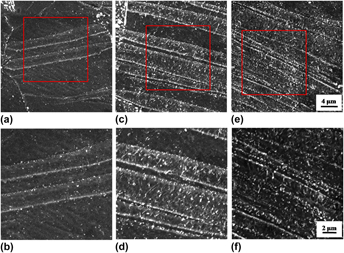Crossref Citations
This article has been cited by the following publications. This list is generated based on data provided by
Crossref.
Chen, Hongbing
Liu, Tianmo
Zhang, Yin
Song, Bo
Hou, Dewen
and
Pan, Fusheng
2016.
The yield asymmetry and precipitation behavior of pre-twinned ZK60 alloy.
Materials Science and Engineering: A,
Vol. 652,
Issue. ,
p.
167.
Wang, Chunpeng
Xin, Renlong
Li, Dongrong
Song, Bo
Liu, Zhe
and
Liu, Qing
2017.
Tailoring the Microstructure and Mechanical Property of AZ80 Alloys by Multiple Twinning and Aging Precipitation.
Advanced Engineering Materials,
Vol. 19,
Issue. 11,
Wang, Chunpeng
Xin, Renlong
Li, Dongrong
Song, Bo
Wu, Mingyu
and
Liu, Qing
2017.
Enhancing the age-hardening response of rolled AZ80 alloy by pre-twinning deformation.
Materials Science and Engineering: A,
Vol. 680,
Issue. ,
p.
152.
Song, Bo
Wang, Chunpeng
Guo, Ning
Pan, Hucheng
and
Xin, Renlong
2017.
Improving Tensile and Compressive Properties of an Extruded AZ91 Rod by the Combined Use of Torsion Deformation and Aging Treatment.
Materials,
Vol. 10,
Issue. 3,
p.
280.
Saadati, Mohammad
Azari Khosroshahi, Rasoul
Ebrahimi, Golamreza
and
Jahazi, Mohammad
2017.
Twin-assisted precipitation during hot compression of an Mg-Gd-Zn-Zr magnesium alloy.
Materials Science and Engineering: A,
Vol. 706,
Issue. ,
p.
142.
Kang, Y.H.
Wang, X.X.
Zhang, N.
Yan, H.
and
Chen, R.S.
2017.
Effect of pre-deformation on microstructure and mechanical properties of WE43 magnesium alloy.
Materials Science and Engineering: A,
Vol. 689,
Issue. ,
p.
435.
Liu, Yu
Jiang, Qike
Liu, Yunteng
Liu, Hongtao
and
Lin, Tao
2018.
Effect of twins on the crystallographic characteristics of the Mg17Al12 phase in the pre-compressed AZ91 alloy.
Materials Letters,
Vol. 230,
Issue. ,
p.
166.
Song, Bo
Liu, Tingting
Xin, Renlong
Yang, Hong
Guo, Ning
Chai, Linjiang
Huang, Yuanding
and
Hort, Norbert
2019.
Influence of Torsion on Precipitation and Hardening Effects during Aging of an Extruded AZ91 Alloy.
Journal of Materials Engineering and Performance,
Vol. 28,
Issue. 7,
p.
4403.
Song, Bo
She, Jia
Guo, Ning
Qiu, Risheng
Pan, Hucheng
Chai, Linjiang
Yang, Changlin
Guo, Shengfeng
and
Xin, Renlong
2019.
Regulating Precipitates by Simple Cold Deformations to Strengthen Mg Alloys: A Review.
Materials,
Vol. 12,
Issue. 16,
p.
2507.
Song, Bo
Yang, Qingshan
Zhou, Tao
Chai, Linjiang
Guo, Ning
Liu, Tingting
Guo, Shengfeng
and
Xin, Renlong
2019.
Texture control by {10-12} twinning to improve the formability of Mg alloys: A review.
Journal of Materials Science & Technology,
Vol. 35,
Issue. 10,
p.
2269.
Shi, Guoliang
Yuan, Jiawei
Li, Ting
Zhang, Kui
Li, Xinggang
Li, Yongjun
and
Ma, Minglong
2020.
Enhanced precipitation strengthening of extruded Mg-8 wt.%Al-0.5 wt.%Zn (AZ80) magnesium alloy by extension twinning.
Materials Science and Engineering: A,
Vol. 774,
Issue. ,
p.
138906.
Nie, Huihui
Hao, Xinwei
Kang, Xiaoping
Chen, Hongsheng
Chi, Chengzhong
and
Liang, Wei
2020.
Strength and plasticity improvement of AZ31 sheet by pre-inducing large volume fraction of {10–12} tensile twins.
Materials Science and Engineering: A,
Vol. 776,
Issue. ,
p.
139045.
Liu, Tingting
Yang, Qingshan
Guo, Ning
Lu, Yun
and
Song, Bo
2020.
Stability of twins in Mg alloys – A short review.
Journal of Magnesium and Alloys,
Vol. 8,
Issue. 1,
p.
66.
He, Jiejun
and
Wu, Lushu
2022.
Strengthening of Mg-6Al-1Zn Alloy via Simultaneous Loading and Aging.
Materials,
Vol. 15,
Issue. 8,
p.
2782.
Chang, Guoqi
Li, Wei
Deng, Guisheng
and
Liu, Yuandong
2023.
Improvement of dynamic compression properties and strengthening mechanism of Mg–Y–Nd–Gd–Zr alloy by pre-twinning.
Journal of Materials Science,
Vol. 58,
Issue. 20,
p.
8515.
Kim, Hyun Ji
Kim, Ye Jin
and
Park, Sung Hyuk
2023.
Acceleration of aging behavior and improvement of mechanical properties of extruded AZ80 alloy through (10–12) twinning.
Journal of Magnesium and Alloys,
Vol. 11,
Issue. 2,
p.
671.
Zhang, Zhen
Wang, Lifei
Wu, Hong-Hui
Pan, Xiaohuan
Gao, Bo
Zheng, Liuwei
Wang, Hongxia
and
Shin, Kwang Seon
2023.
The effect of induced precipitations and pre-twins on the bending neutral layer migration behaviors of AZ80 Mg alloy sheet.
Journal of Materials Research and Technology,
Vol. 27,
Issue. ,
p.
6645.
Shi, Guo-Liang
Zhang, Kui
Li, Xing-Gang
Li, Yong-Jun
Ma, Ming-Long
Yuan, Jia-Wei
and
Zhang, Hong-Ju
2023.
Dislocation configuration evolution during extension twinning and its influence on precipitation behavior in AZ80 wrought magnesium alloy.
Journal of Magnesium and Alloys,
Vol. 11,
Issue. 7,
p.
2442.
Pei, Di
TingliangYan
Wang, Li
Hu, Xuhao
Li, Xinlin
and
Wang, Xiang
2024.
Dynamic precipitation and twinning-induced dynamic recrystallization in Mg–6Al–3Sn–1Zn alloy during multi-pass high-speed rolling.
Journal of Materials Research and Technology,
Vol. 30,
Issue. ,
p.
2200.
Yu, Hang
Guo, Fei
Ma, Yanlong
Wang, Yi
Li, Xiaoyan
Li, Ke
Jiang, Luyao
and
Liu, Haiding
2024.
Continuous precipitation behavior of Mg17Al12 phase during multiple steps of twinning-aging procedure in Mg-Al alloys.
Journal of Alloys and Compounds,
Vol. 987,
Issue. ,
p.
174188.





